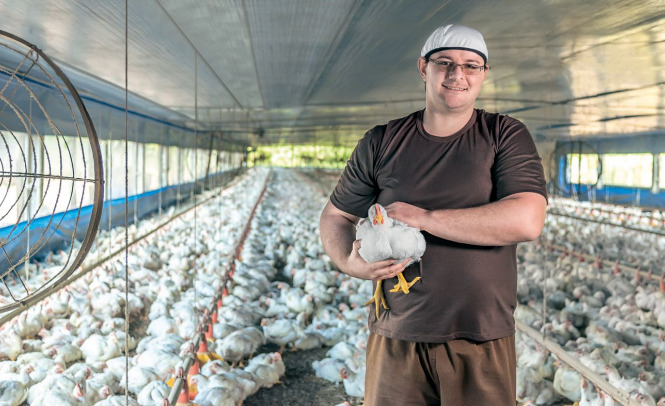Ricardo Santin, president of the Brazilian Animal Protein Association (ABPA), highlighted the low probability of transmission of the H5N1 virus through imported meat.
Also president of the International Poultry Council, Santin released a critical analysis of this health risk and its global economic implications.
The H5N1 Highly Pathogenic Avian Influenza (HPAI) virus is a significant pathogen, posing risks primarily to animal health and having significant impacts on food safety and international trade.
Transmission of the H5N1 virus
Despite its ability to persist in raw poultry products, Santin critically analyzes the possibility of virus transmission to local industrial poultry production through imported meat inspected by a recognized veterinary service.
Based on evidence from intergovernmental organizations (WOAH/OIE, FAO, WHO, CDC, FDA), he concludes that the risk is virtually nil.
Therefore, he advocates for the revision of trade policies based on an obsolete precautionary principle, proposing a new balanced approach that preserves both animal health and access to poultry protein essential for vulnerable populations.
Santin’s views are presented below:
Health control
H5N1 avian influenza has attracted increasing attention since its emergence in the 2000s. Its lethality in birds and its capacity for sporadic transmission to humans have caused global concern. In addition, its impact has hit international trade in poultry products hard.
The main transmission occurs between live birds, either through direct contact or exposure to secretions and feces. However, fears of food contamination led to the imposition of trade barriers. In many cases, these measures were disproportionate, even against chains under strict health controls.
H5N1 resistance to freezing
Laboratory studies show that the H5N1 virus can survive in frozen raw meat. Its viability is maintained for more than 60 days at -18°C or below. However, this resistance does not pose a real risk of infection.
The danger disappears under strict sanitary controls. First, when the meat undergoes veterinary inspection before and after slaughter. Then, when it undergoes controlled industrial processes. Finally, when it is intended for human consumption and cooked at temperatures of 74°C or higher. This condition inactivates the virus before it reaches the consumer, according to data from the CDC, FDA, and FAO/WOAH.
Risk analysis for local industrial production
In certain scenarios, the risk of introducing H5N1 into live animals through imported meat is practically zero. This occurs when countries use heat-treated industrial feed, keep farms isolated, and prohibit raw by-products in animal feed.
In addition, the risk is reduced when waste is disposed of in a controlled manner and routine health inspections are carried out. According to epidemiological criteria, the threat level is close to zero.
The WOAH considers trade in meat from slaughtered poultry under inspection to be safe. It even accepts imports from countries with outbreaks of avian influenza, provided that the products do not come from the source of the outbreak. Therefore, the zoning proposal should be urgently evaluated in countries that do not yet apply it in their trade relations.
The precautionary principle: when it becomes a trade barrier
Strict application of the precautionary principle can be counterproductive. This is especially true for products that have already passed health inspections and are intended for human consumption. In such cases, trade measures may be unnecessary and disproportionate to the actual threat.
The closure of poultry meat markets under these conditions has clear effects. It does not significantly reduce health risks. Furthermore, it penalizes exporting countries economically. It also causes food inflation in importing countries and mainly affects low-income populations, limiting access to proteins of high biological value and rich in essential amino acids.
The migratory bird paradox
While the importation of meat inspected under strict precautions is prohibited, migratory birds continue to circulate freely across borders. They often act as asymptomatic vectors of the highly pathogenic avian influenza virus.
Ignoring this natural source of dissemination and overestimating the risk of industrialized foods shows an inconsistency in international health policies. Therefore, these policies require urgent review, considering the available technical and economic evidence.
Conclusion
Under controlled conditions of production, slaughter, and processing, poultry products intended for human consumption do not pose a health risk to industrial farms in other countries. This is true as long as they are not redirected to animal feed or delivered to live birds. The risk of HPAI virus transmission through this route is practically negligible, technically zero.
In this context, trade restrictions based on an exaggerated precautionary principle lack technical and practical justification. Furthermore, they affect the global supply of poultry products, destabilize markets, and undermine the nutritional well-being of the most vulnerable populations.
A change in the regulatory paradigm is proposed. This should be based on actual risk, science, and proportionality. It recognizes that zoonoses circulate naturally, including through uncontrollable means such as the migration of wild birds. After all, what greater risk do poultry products pose that is not already present in wild or migratory birds?
References:
- World Organization for Animal Health (WOAH/OIE). Terrestrial Animal Health Code, 2023.
- Food and Agriculture Organization (FAO), 2023. Avian Influenza Risk Management for Trade.
- Centers for Disease Control and Prevention (CDC). Highly Pathogenic Avian Influenza (HPAI) and Food Safety, 2024.
- World Health Organization (WHO). Avian Influenza: Assessing the pandemic risk, 2024.
- U.S. Food and Drug Administration (FDA). Avian Influenza and Food Products, 2024.
- PAHO/WHO. Avian Influenza Technical Bulletin, 2023.

